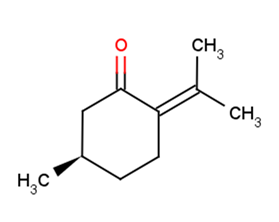
Pulegone
CAS No. 89-82-7
Pulegone( Pulegone | NSC 15334 | NSC15334 | D-Pulegone )
Catalog No. M19240 CAS No. 89-82-7
Pulegone has cytotoxicity followed by regenerative cell proliferation is the MOA for Pulegone-induced urothelial tumors in female rats.
Purity : >98% (HPLC)
 COA
COA
 Datasheet
Datasheet
 HNMR
HNMR
 HPLC
HPLC
 MSDS
MSDS
 Handing Instructions
Handing Instructions
| Size | Price / USD | Stock | Quantity |
| 5MG | 35 | In Stock |


|
| 10MG | 50 | In Stock |


|
| 25MG | 82 | In Stock |


|
| 50MG | 120 | In Stock |


|
| 100MG | 178 | In Stock |


|
| 200MG | Get Quote | In Stock |


|
| 500MG | Get Quote | In Stock |


|
| 1G | Get Quote | In Stock |


|
Biological Information
-
Product NamePulegone
-
NoteResearch use only, not for human use.
-
Brief DescriptionPulegone has cytotoxicity followed by regenerative cell proliferation is the MOA for Pulegone-induced urothelial tumors in female rats.
-
DescriptionPulegone has cytotoxicity followed by regenerative cell proliferation is the MOA for Pulegone-induced urothelial tumors in female rats. Pulegone induces a verapamil-sensitive psychostimulant effect that appears to independ on the opening of L-type calcium channels. Pulegone has negative reinforcing properties and seems to possess anxiolytic-like actions unrelated to the benzodiazepine site of the γ-aminobutyric acid type A (GABAA) receptor.
-
In Vitro——
-
In Vivo——
-
SynonymsPulegone | NSC 15334 | NSC15334 | D-Pulegone
-
PathwayTyrosine Kinase
-
TargetSrc
-
RecptorL-type calcium channel
-
Research AreaOthers-Field
-
Indication——
Chemical Information
-
CAS Number89-82-7
-
Formula Weight152.23
-
Molecular FormulaC10H16O
-
Purity>98% (HPLC)
-
SolubilityIn Vitro:?DMSO : ≥ 270 mg/mL (1773.63 m)
-
SMILESCC1CCC(=C(C)C)C(=O)C1
-
Chemical NameCyclohexanone, 5-methyl-2-(1-methylethylidene)-, (R)-
Shipping & Storage Information
-
Storage(-20℃)
-
ShippingWith Ice Pack
-
Stability≥ 2 years
Reference
molnova catalog



related products
-
WH-4-023
WH-4-023 is a potent and orally active Lck/Src inhibitor with IC50 of 2 nM and 6 nM in cell-free assays, respectively.
-
Genkwanin
Genkwanin exerts its anti-inflammatory effect mainly through the regulation of the miR-11/MKP-1/MAPK pathway.
-
SB273005
SB273005 is a potent integrin inhibitor with Ki of 1.2 nM and 0.3 nM for αvβ3 receptor and αvβ5 receptor, respectively.



 Cart
Cart
 sales@molnova.com
sales@molnova.com


